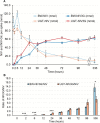A barley UDP-glucosyltransferase inactivates nivalenol and provides Fusarium Head Blight resistance in transgenic wheat
- PMID: 28407119
- PMCID: PMC5447872
- DOI: 10.1093/jxb/erx109
A barley UDP-glucosyltransferase inactivates nivalenol and provides Fusarium Head Blight resistance in transgenic wheat
Abstract
Fusarium Head Blight is a disease of cereal crops that causes severe yield losses and mycotoxin contamination of grain. The main causal pathogen, Fusarium graminearum, produces the trichothecene toxins deoxynivalenol or nivalenol as virulence factors. Nivalenol-producing isolates are most prevalent in Asia but co-exist with deoxynivalenol producers in lower frequency in North America and Europe. Previous studies identified a barley UDP-glucosyltransferase, HvUGT13248, that efficiently detoxifies deoxynivalenol, and when expressed in transgenic wheat results in high levels of type II resistance against deoxynivalenol-producing F. graminearum. Here we show that HvUGT13248 is also capable of converting nivalenol into the non-toxic nivalenol-3-O-β-d-glucoside. We describe the enzymatic preparation of a nivalenol-glucoside standard and its use in development of an analytical method to detect the nivalenol-glucoside conjugate. Recombinant Escherichia coli expressing HvUGT13248 glycosylates nivalenol more efficiently than deoxynivalenol. Overexpression in yeast, Arabidopsis thaliana, and wheat leads to increased nivalenol resistance. Increased ability to convert nivalenol to nivalenol-glucoside was observed in transgenic wheat, which also exhibits type II resistance to a nivalenol-producing F. graminearum strain. Our results demonstrate the HvUGT13248 can act to detoxify deoxynivalenol and nivalenol and provide resistance to deoxynivalenol- and nivalenol-producing Fusarium.
Keywords: Fusarium Head Blight; Fusarium graminearum; UDP-glycosyltransferase; nivalenol; trichothecene; wheat..
© The Author 2017. Published by Oxford University Press on behalf of the Society for Experimental Biology.
Figures





Similar articles
-
Transgenic Wheat Expressing a Barley UDP-Glucosyltransferase Detoxifies Deoxynivalenol and Provides High Levels of Resistance to Fusarium graminearum.Mol Plant Microbe Interact. 2015 Nov;28(11):1237-46. doi: 10.1094/MPMI-03-15-0062-R. Epub 2015 Oct 23. Mol Plant Microbe Interact. 2015. PMID: 26214711
-
Transgenic Arabidopsis thaliana expressing a barley UDP-glucosyltransferase exhibit resistance to the mycotoxin deoxynivalenol.J Exp Bot. 2012 Aug;63(13):4731-40. doi: 10.1093/jxb/ers141. J Exp Bot. 2012. PMID: 22922639 Free PMC article.
-
Transgene pyramiding in wheat: Combination of deoxynivalenol detoxification with inhibition of cell wall degrading enzymes to contrast Fusarium Head Blight and Crown Rot.Plant Sci. 2021 Dec;313:111059. doi: 10.1016/j.plantsci.2021.111059. Epub 2021 Sep 17. Plant Sci. 2021. PMID: 34763853
-
Resistance in wheat to Fusarium infection and trichothecene formation.Toxicol Lett. 2004 Oct 10;153(1):37-46. doi: 10.1016/j.toxlet.2004.04.044. Toxicol Lett. 2004. PMID: 15342079 Review.
-
Trichothecenes in Cereal Grains - An Update.Toxins (Basel). 2019 Oct 31;11(11):634. doi: 10.3390/toxins11110634. Toxins (Basel). 2019. PMID: 31683661 Free PMC article. Review.
Cited by
-
Linking Multi-Omics to Wheat Resistance Types to Fusarium Head Blight to Reveal the Underlying Mechanisms.Int J Mol Sci. 2022 Feb 18;23(4):2280. doi: 10.3390/ijms23042280. Int J Mol Sci. 2022. PMID: 35216395 Free PMC article. Review.
-
Validation and delineation of a locus conferring Fusarium crown rot resistance on 1HL in barley by analysing transcriptomes from multiple pairs of near isogenic lines.BMC Genomics. 2019 Aug 14;20(1):650. doi: 10.1186/s12864-019-6011-8. BMC Genomics. 2019. PMID: 31412765 Free PMC article.
-
Metabolic pathway genes for editing to enhance multiple disease resistance in plants.J Plant Res. 2022 Nov;135(6):705-722. doi: 10.1007/s10265-022-01409-5. Epub 2022 Aug 29. J Plant Res. 2022. PMID: 36036859
-
Enzymes for Detoxification of Various Mycotoxins: Origins and Mechanisms of Catalytic Action.Molecules. 2019 Jun 26;24(13):2362. doi: 10.3390/molecules24132362. Molecules. 2019. PMID: 31247992 Free PMC article. Review.
-
Dual RNA-sequencing of Fusarium head blight resistance in winter wheat.Front Plant Sci. 2024 Jan 4;14:1299461. doi: 10.3389/fpls.2023.1299461. eCollection 2023. Front Plant Sci. 2024. PMID: 38239218 Free PMC article.
References
-
- Alassane-Kpembi I, Kolf-Clauw M, Gauthier T, Abrami R, Abiola FA, Oswald IP, Puel O. 2013. New insights into mycotoxin mixtures: the toxicity of low doses of Type B trichothecenes on intestinal epithelial cells is synergistic. Toxicology and Applied Pharmacology 272, 191–198. - PubMed
-
- Alexander NJ, McCormick SP, Waalwijk C, van der Lee T, Proctor RH. 2011. The genetic basis for 3-ADON and 15-ADON trichothecene chemotypes in Fusarium. Fungal Genetics and Biology 48, 485–495. - PubMed
-
- Bai GH, Desjardins AE, Plattner RD. 2002. Deoxynivalenol-nonproducing Fusarium graminearum causes initial infection, but does not cause disease spread in wheat spikes. Mycopathologia 153, 91–98. - PubMed
-
- Brown DW, McCormick SP, Alexander NJ, Proctor RH, Desjardins AE. 2002. Inactivation of a cytochrome P-450 is a determinant of trichothecene diversity in Fusarium species. Fungal Genetics and Biology 36, 224–233. - PubMed
Publication types
MeSH terms
Substances
LinkOut - more resources
Full Text Sources
Other Literature Sources
Molecular Biology Databases

